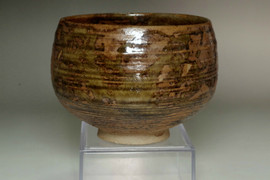Aoki Mokubei (1767-1833) Antique kutani pottery cup #4472
- SKU:
- 4472
- Condition:
- Used
- Shipping:
- Free Shipping
- width: approx. 9.2cm (3 5⁄8iin)
- height: approx. 6cm (2 23⁄64in)
- weight: 137g
Aoki Mokubei was born in the Gion district of Kyoto as Aoki Sahei.
From childhood, he was a disciple of the well known artist and Confucianist Kou Fuyou, who had a strong influence on his upbringing.
When he visited Kimura Kenkadou of Osaka, he found among his book collection a book written by the Chinese Shuryuutei called “Guide to Ceramics”, which, it is said, inspired him to decide that ceramic art was his life’s calling.
It is said that his mentors in ceramic art were Okuda Eisen, who taught him how to work porcelain, and Houzan Bunzou the 11th, who taught him how to work pottery, although it is also said that most of his knowledge was gained through self study.
He set up shop in the Awata region of Kyoto. He took the name of the tea house run by his family, “Ki” (木), combined the characters of his nickname “Yasohachi” (八十八) into one character, “Kome” (米), and added them together to create the name “Mokubei” (木米), and worked under that name. With his natural genius, he became one of the most famous potters in Kyoto-Osaka after just a few years. In 1801, Tokugawa Harutomi of the Wakayama area heard of his fame and invited him to participate in the construction of the Zuishi kiln. It is said that this is when he was bestowed with the Silver Seal of Teiunrou, but there are differing opinions and no concrete evidence.
In 1805, he was ordered to serve at Awata Palace. The next year, he went to Kanazawa, in Kaga Domain, and began working at Mount Utatsu. He briefly returned to Kyoto before going back to Kanazawa in 1807, where he established the Kasuga-yama kiln. After abandoning it to return to Kyoto, he stayed in Kyoto permanently and continued his pottery there. In addition to the Chinese and Choson styles, he researched many different styles of ceramic art such as European, Cochin ware, blue and white pottery, akae (enamel decoration on porcelain), Dehua pottery, and Mishima ware. He created a lot of tea utensils, focusing mainly on kettles, and those creations became the foundation for modern Japanese tea utensils, referred to today as “Mokubei style”. In addition to pottery, he excelled in painting and Han Studies, had a sophisticated demeanor, and made close friends with many intellectuals such as Tanomura Rakuden and Rai San’yo.
His representative work, “Bokutansai Sansui-zu” and other works have been classified as Important Cultural Properties of Japan.
Thank you!














